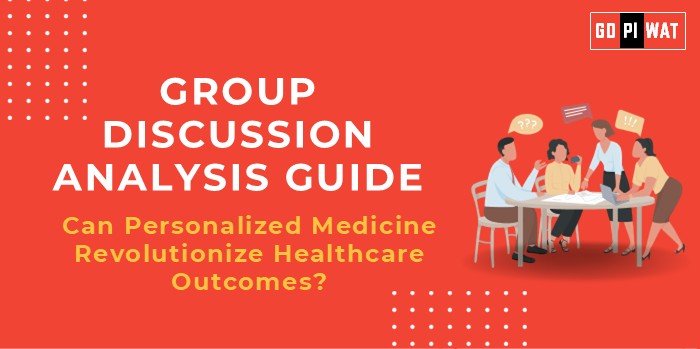📋 Group Discussion Analysis Guide
🌐 Introduction to Personalized Medicine
Opening Context: “With advancements in genomics, AI, and data analytics, personalized medicine is reshaping the global healthcare landscape by offering tailored treatments based on individual profiles.”
Topic Background: Personalized medicine integrates genetic, environmental, and lifestyle factors to design specific treatments. Initiatives like the Human Genome Project and advances in bioinformatics have made this approach feasible, promising better healthcare outcomes.
📊 Quick Facts and Key Statistics
- Global Market Size: $2.1 billion (2023), expected to grow at a CAGR of 11.8% through 2030. (Source: Global Market Insights)
- Cost Reductions: Pharmacogenomics reduces adverse drug reactions, saving an estimated $136 billion annually in the U.S.
- Technological Advancements: Over 50% of FDA-approved drugs in 2023 included genetic biomarkers.
- Patient Impact: A 2023 study showed a 40% higher success rate for targeted cancer therapies compared to traditional methods.
🏥 Stakeholders and Their Roles
- Governments: Funding research, creating frameworks, and ensuring equity.
- Healthcare Providers: Implementing personalized treatments in clinical settings.
- Biotech and Pharma Companies: Innovating precision drugs and diagnostics.
- Patients: Advocating for tailored therapies and sharing data responsibly.
✨ Achievements and Challenges
🎉 Achievements:
- Improved outcomes: Targeted therapies in oncology, such as HER2-positive breast cancer treatments, have significantly improved survival rates.
- Technological strides: CRISPR and AI are enabling precise genome editing and predictive diagnostics.
- Cost efficiency: Personalized approaches reduce trial-and-error in treatments, saving costs in the long run.
⚠️ Challenges:
- Cost barriers: Personalized treatments are expensive, limiting accessibility.
- Ethical dilemmas: Privacy concerns with genetic data and the risk of misuse.
- Infrastructure: Lack of widespread genomic testing facilities in developing nations.
🌍 Global Comparisons:
- USA: Leading in genomic research and implementation.
- Finland: Successfully integrating population genomics into public health.
📖 Case Studies:
- India: AI-based personalized diabetes management programs showing 20% better patient adherence rates.
🧠 Structured Arguments for Discussion
- Supporting Stance: “Personalized medicine reduces trial-and-error treatments, enhancing patient care and resource utilization.”
- Opposing Stance: “High costs and limited access may exacerbate healthcare inequalities, especially in resource-limited settings.”
- Balanced Perspective: “While promising, personalized medicine requires equitable frameworks and cost reduction strategies to realize its full potential.”
📣 Effective Discussion Approaches
- Opening Approaches:
- Highlighting a statistic: “Over 50% of drugs approved in 2023 involved genetic markers, showing the potential of precision medicine.”
- Posing a dilemma: “Can the promise of personalized medicine outweigh its challenges of cost and access?”
- Counter-Argument Handling: Example: “Though expensive, economies of scale and innovations like AI can drive down costs over time.”
⚖️ Strategic Analysis of Strengths and Weaknesses
✅ Strengths:
- Precise treatments.
- Fewer side effects.
- Potential cost savings in long-term care.
❌ Weaknesses:
- High initial costs.
- Data privacy concerns.
- Limited infrastructure in developing regions.
💡 Opportunities:
- Integration of AI.
- Wider adoption of genomics.
- Global collaboration.
⚠️ Threats:
- Ethical dilemmas.
- Data breaches.
- Inequity in access.
📚 Connecting with B-School Applications
- Real-World Applications: Exploring AI-driven healthcare, creating business models for accessible personalized treatments.
- Sample Interview Questions:
- “How can personalized medicine address disparities in global healthcare?”
- “Evaluate the role of technology in making healthcare personalized.”
- Insights for B-School Students:
- Personalized medicine is fertile ground for innovations in healthcare management, operational efficiency, and ethical governance.


